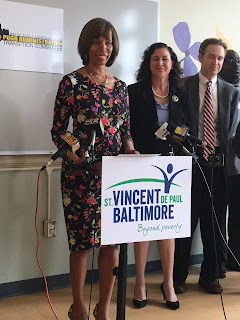 |
| Is the sun rising over Baltimore? (Photo: Ed Hord) |
In spite of this predictable finding, yes, the City has changed. One would have to just look at the panels explaining LightCity Baltimore or have gone to one of the discussion sessions to see that equity and social justice have taken a front row seat in any discourse about Baltimore, whether it is police, education or transportation. Of course, discourse is one thing and the physical and social reality in the neighborhoods is another. But even there tangible change is present, though, by far not enough of it.
Sarah's Hope expansion and its new Under Armour playground in Sandtown do not turn the neighborhood around. Doubling down on the East Baltimore Mary Harvin resource and senior center that burnt down on the night of the unrest and opened a year later anyway doesn't save East Baltimore. A consent decree of the Justice Department that has to be clawed from the Attorney General through swift legal action does not alone create justice in our streets. The Governor's acclamation of Baltimore rings hollow after he took with State Center a second multi-billion dollar Baltimore project off the table. The new Mayor balked at the $15 minimum wage, crime is on all time record levels and population seems to once again decline. In some ways change is going in the wrong direction.
 |
| Mayor Pugh announcing her transition team in Sandtown at Sarah's Hope |
But let's not forget, that Baltimore has a new Mayor is a direct result of the unrest and the drastically changed City Council is as well. A new Housing Commissioner and a new Transportation Director are expected soon. The largest community benefits agreement in the history of this city wouldn't have happened without the unrest, nor would BUILD likely have found a way to regain as much strength. Neither De Ray McCesson nor the Police Commissioner would have been on MNBC to talk about police brutality and justice nor would have Zeke Cohen been invited to debate with Tucker Carlson. The Innovation Village wouldn't be the anchor of Madison Park North on North Avenue and the Urban Land Institute would not have held a Technical Advisory Panel for Pennsylvania Avenue. Many Obama initiated federal grants such as North Avenue Rising would have come to Baltimore either. Even MTA's bus reform planned for June of this year may not have happened in the same way without Baltimore's unrest which shed a stark light on Baltimore's transportation inequalities.
 |
| Unabated decay in Sandtown (Photo: Brough Schamp) |
But no, we didn't have a moonshot and I don't know anybody who can outline what the appropriate moonshot project would look like. Even the Mayor's renewed effort to turn around Park Heights, one of the largest depressed areas of Baltimore, is hardly a silver bullet, with or without casino benefits dollars, with or without Pimlico. I recently pointed to Cincinnati and the successful turn-around of its poorest neighborhood Over the Rhine after its own unrest in 2001 as a kind of moonshot that came about through an all out effort of a non-profit development corporation funded by local corporations.
But Baltimore is so big and so disinvested that even EBDI, a case run similar to the Cincinnati development corporation, but much less successful, Barclay, Oliver, Remington (successful turn-arounds), a reinvigorated Park Heights Renaissance and a rejuvenated Remington combined aren't enough to make the kind of difference that could be seen as moving Baltimore once and for all back from the cliff. For a much more dramatic action private corporartions would need to step up in a much bigger way.
Instead, a thousand small initiatives such as the Turnaround Tuesdays re-entry program, Ericka Alston's Kid's Zone on Pennsylvania Avenue, Elder Harris Intersection of Change, Roscoe Johnson's Druid Heights CDC, Holman's Open Works, the Living Classrooms (Fresh Start), Hunanim's Details and many, many others like it chug along with renewed purpose and urgency.
It is absolutely possible that the chaos and ill-will in Washington can inflict additional irreparable harm on Baltimore, dependent on federal money and employment as it is. It is possible that corrupt police officers and corrupt individual legislators deepen the suburban suspicions even further. So far, the unrest of 2015 did not have the devastating effects of 1968. It managed to shake the City into a state of acute awareness but not one of paralysis.
Klaus Philipsen, FAIA
No comments:
Post a Comment